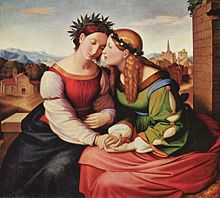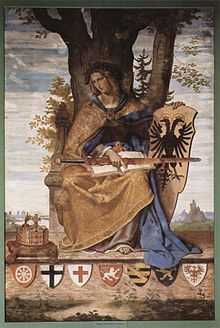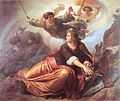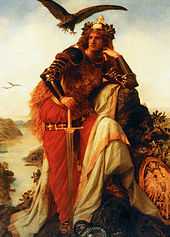Germania (personification)
.jpg)
Germania is the personification of the German nation or the Germans as a whole, most commonly associated with the Romantic Era and the Revolutions of 1848, though the figure was later used by Imperial Germany.
Description
Germania is usually shown as a robust woman with long, flowing, reddish-blonde hair and wearing armour. She often wields the "Reichsschwert" (imperial sword), and possesses a mediaeval-style shield that sometimes bears the image of a black eagle on a gold field. Additionally, she is sometimes shown as carrying or wearing the Imperial Crown of the Holy Roman Empire.
In post-1918 images, the banner she holds is the black-red-gold flag of modern Germany, but in depictions from 1871 to 1918 it is the black-white-red flag of the German Empire.
Meanings of some symbols
| Attribute | Significance |
|---|---|
| Broken chains | Being freed |
| Breastplate with eagle | Symbol of the German empire - strength |
| Crown of oak leaves | Heroism |
| Sword | Symbol of power |
| Chastetree branch around the sword | Noli tangere (touch-me-not), warning/protection |
| Black, red and gold tricolour | Flag of the liberal-nationalists in 1848; banned by dukes of the German states |
| Rays of the rising sun | Beginning of a new era |
Gallery
-

Italia and Germania by Johann Friedrich Overbeck, 1828
-

Fresco by Philipp Veit, 1834–36. She is holding a shield with the German Confederation's arms. The smaller shields are the arms of the seven original Electors of the Holy Roman Empire.
-

Germania Awakening by Christian Köhler , 1849
-

Germania at the Watch on the Rhine by Hermann Wislicenus, 1873
-

Statue by Johannes Schilling, 1877-83, part of the Niederwalddenkmal near Rüdesheim am Rhein
-
Statue from Bismarck Memorial in Berlin, 1901
-

Germany 1914, by Friedrich August von Kaulbach
See also
- Flag and Coat of Arms of Germany
- Bavaria statue, personification of the Land of Bavaria
- Berolina, personification of Berlin
- Deutscher Michel, personification of the German people
- Hammonia, personification of Hamburg
References
- Lionel Gossman. "Making of a Romantic Icon: The Religious Context of Friedrich Overbeck’s 'Italia und Germania'." American Philosophical Society, 2007. ISBN 0-87169-975-3.
External links
| Wikimedia Commons has media related to Germania. |
- Germania Briefmarken (German)
